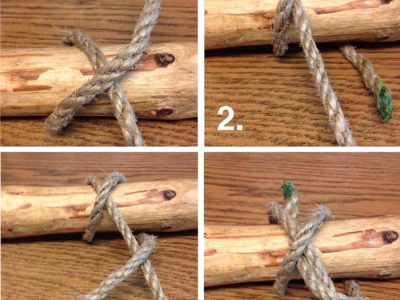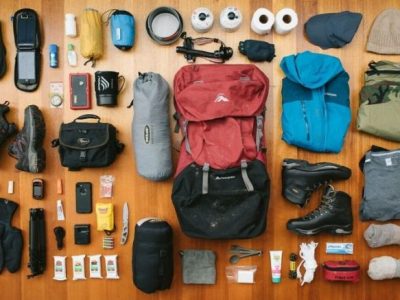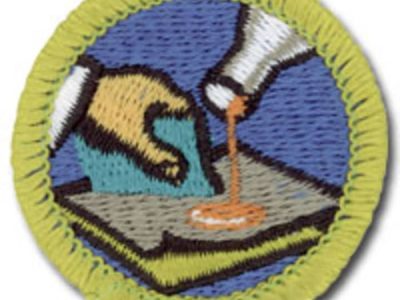Water purification systems for camping are essential for ensuring safe drinking water while enjoying the great outdoors. With various types of systems available, choosing the right one depends on specific needs and preferences. Understanding the importance of water purification and the factors to consider when selecting a system is crucial for a safe and enjoyable camping experience.
Contaminated water sources pose significant health risks, making water purification a necessity. From surface water to groundwater, different water sources may contain harmful bacteria, viruses, and parasites. Water purification systems effectively remove these contaminants, ensuring the safety of drinking water.
Introduction
Water purification is essential for camping as it removes impurities and contaminants from water sources, making it safe for drinking. There are various types of water purification systems available for camping, each with its own advantages and disadvantages.
Some common types of water purification systems include:
Filtration, Water purification systems for camping
Filtration systems use a physical barrier to remove particles from water. They can be simple filters made of cloth or paper, or more complex systems that use activated carbon or ceramic filters. Filtration systems are generally effective at removing bacteria, protozoa, and other large particles, but they may not be able to remove viruses or dissolved chemicals.
Chemical Treatment
Chemical treatment systems use chemicals, such as chlorine or iodine, to kill bacteria and other microorganisms in water. Chemical treatment systems are effective at removing a wide range of contaminants, but they can leave a residual taste in water and may not be suitable for people with certain health conditions.
Ultraviolet (UV) Treatment
UV treatment systems use ultraviolet light to kill bacteria and other microorganisms in water. UV treatment systems are effective at removing a wide range of contaminants, and they do not leave a residual taste in water. However, UV treatment systems can be more expensive than other types of water purification systems.
Reverse Osmosis
Reverse osmosis systems use a semipermeable membrane to remove impurities and contaminants from water. Reverse osmosis systems are very effective at removing a wide range of contaminants, including bacteria, viruses, and dissolved chemicals. However, reverse osmosis systems can be expensive and require a lot of energy to operate.
Factors to Consider When Choosing a Water Purification System
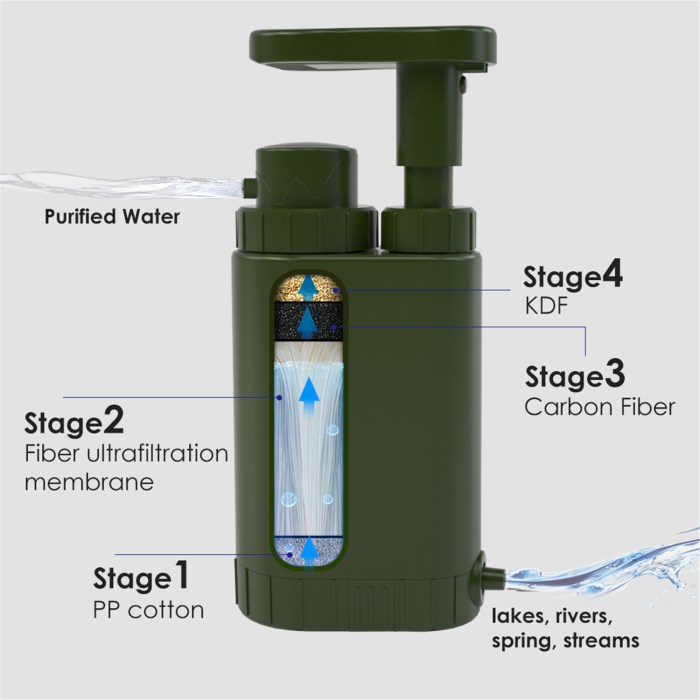
When selecting a water purification system for camping, several factors should be taken into account to ensure the system meets specific needs and provides reliable clean water. These factors include the water source, contaminants present, desired level of purification, flow rate, ease of use, and weight and portability.
Water Source
The water source, whether surface water (e.g., lakes, rivers) or groundwater (e.g., wells, springs), influences the choice of water purification system. Surface water typically contains more contaminants, such as bacteria, viruses, and sediment, requiring a more robust purification system. Groundwater, on the other hand, may contain fewer contaminants but can still harbor bacteria or dissolved minerals.
Contaminants Present
Identifying the potential contaminants present in the water source is crucial. Common contaminants include bacteria, viruses, protozoa, sediment, chemicals, and heavy metals. The type and concentration of contaminants determine the appropriate purification technology, such as filtration, chemical disinfection, or a combination of both.
Desired Level of Purification
The desired level of purification depends on the intended use of the water. For drinking water, a higher level of purification is required to remove harmful pathogens. For washing or cooking, a lower level of purification may be sufficient.
Flow Rate
The flow rate of a water purification system refers to the amount of water it can produce per minute. A higher flow rate is desirable for faster water production, especially when multiple users are present. However, systems with higher flow rates may be bulkier or require more maintenance.
Ease of Use
The ease of use of a water purification system is important for convenience and efficiency. Systems that are simple to operate, maintain, and clean are more likely to be used consistently.
Weight and Portability
For camping trips, the weight and portability of a water purification system are critical considerations. Lightweight and compact systems are easier to carry and store, especially for backpacking or hiking trips.
Types of Water Purification Systems
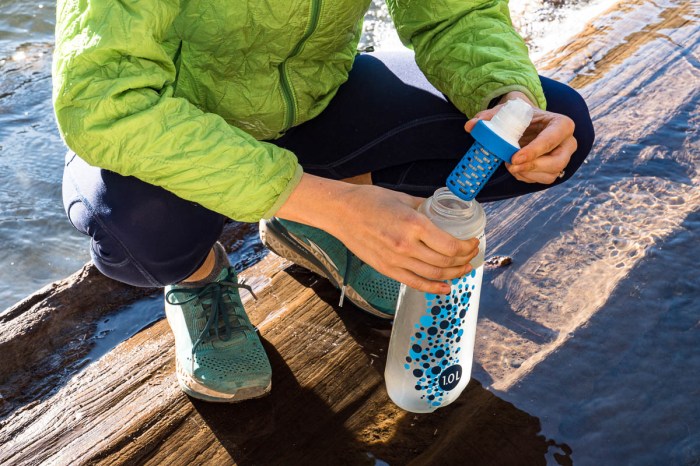
Water purification systems for camping are essential for ensuring access to clean and safe drinking water in the wilderness. Various types of systems are available, each with its own advantages and disadvantages. Here’s an overview of the most common types:
Filtration Systems
Filtration systems physically remove contaminants from water by passing it through a filter made of a fine material. These filters can be made of ceramic, activated carbon, or other materials. Filtration systems are effective at removing sediment, bacteria, and other large particles.
They are relatively easy to use and maintain, making them a popular choice for campers.
Examples of filtration systems include:
- Ceramic filters
- Activated carbon filters
- Gravity filters
- Pump filters
Chemical Disinfection
Chemical disinfection systems use chemicals to kill or inactivate microorganisms in water. The most common chemical used for this purpose is chlorine. Chemical disinfection systems are effective at removing bacteria and viruses, but they can also leave a chemical taste or odor in the water.
It’s important to follow the manufacturer’s instructions carefully when using chemical disinfection systems.
Examples of chemical disinfection systems include:
- Chlorine tablets
- Iodine tablets
- Water purification drops
UV Disinfection
UV disinfection systems use ultraviolet light to kill microorganisms in water. UV light is a powerful disinfectant that can kill bacteria, viruses, and other microorganisms. UV disinfection systems are effective and relatively easy to use, but they can be more expensive than other types of water purification systems.
Examples of UV disinfection systems include:
- UV pens
- UV water bottles
- UV purifiers
Boiling
Boiling water is a simple and effective way to kill microorganisms. Boiling water kills bacteria, viruses, and other microorganisms by destroying their cell walls. It’s important to boil water for at least one minute to ensure that all microorganisms are killed.
Tips for effective boiling:
- Bring water to a full boil.
- Boil water for at least one minute.
- Let water cool before drinking.
How to Use Water Purification Systems: Water Purification Systems For Camping
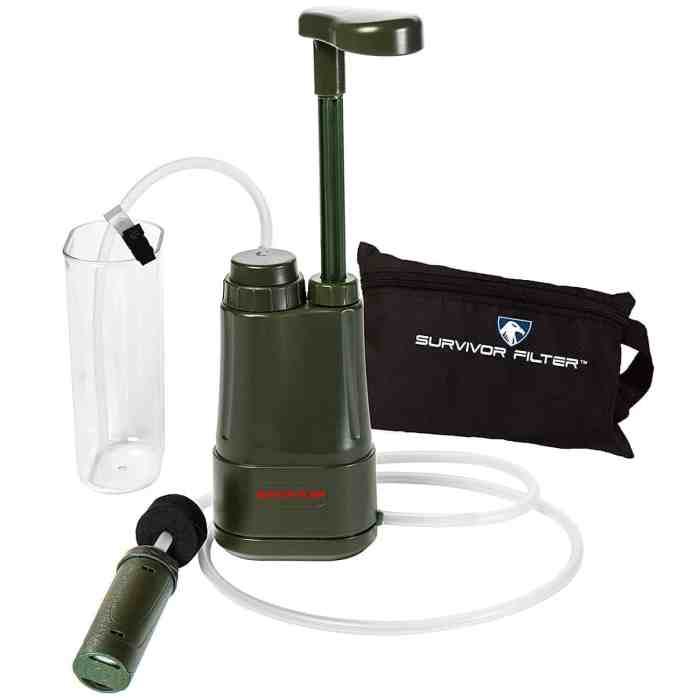
Using a water purification system while camping ensures access to clean and safe drinking water. Different types of systems require specific steps for effective use and maintenance.
Chemical Treatment
Chemical treatment involves adding chemicals, such as chlorine or iodine, to water to kill microorganisms. Follow these steps:
- Read the instructions on the chemical treatment product carefully.
- Add the specified amount of chemical to the water.
- Stir thoroughly and wait for the recommended contact time (usually 30 minutes to 4 hours).
- The water is now disinfected and safe to drink.
Boiling
Boiling is a simple and effective method of water purification. Follow these steps:
- Bring water to a rolling boil for at least 1 minute at sea level (longer at higher altitudes).
- Let the water cool before drinking.
Filtration, Water purification systems for camping
Filtration removes particles and microorganisms from water using a filter. Follow these steps:
- Attach the filter to the water source or use a hand pump.
- Pump or pour water through the filter.
- The filtered water is now safe to drink.
Distillation
Distillation involves boiling water and collecting the condensed steam, which is free of impurities. Follow these steps:
- Fill the distillation unit with water.
- Heat the water until it boils.
- Collect the condensed steam in a separate container.
- The distilled water is now safe to drink.
Maintenance and Storage
Proper maintenance and storage of water purification systems are crucial for their effectiveness. Follow these tips:
- Clean and disinfect filters regularly according to the manufacturer’s instructions.
- Replace filters when necessary.
- Store water purification systems in a dry and protected place when not in use.
Advantages and Disadvantages of Different Water Purification Systems
Water purification systems vary in their effectiveness and suitability for different water sources and camping conditions. Understanding the advantages and disadvantages of each type can help campers choose the most appropriate system for their needs.
Table: Advantages and Disadvantages of Water Purification Systems
| Type | Advantages | Disadvantages |
|---|---|---|
| Chemical Treatment | – Inexpensive
|
– Can leave a chemical taste or odor
|
| Boiling | – Kills all microorganisms
|
– Requires a heat source
|
| Filtration | – Removes particles, sediment, and some microorganisms
|
– May not remove all contaminants, such as viruses
|
| Ultraviolet (UV) Disinfection | – Kills microorganisms using UV light
|
– Requires batteries or a power source
|
| Reverse Osmosis | – Removes a wide range of contaminants, including viruses and heavy metals
|
– Requires a power source
|
Choosing the Right Water Purification System for Your Needs
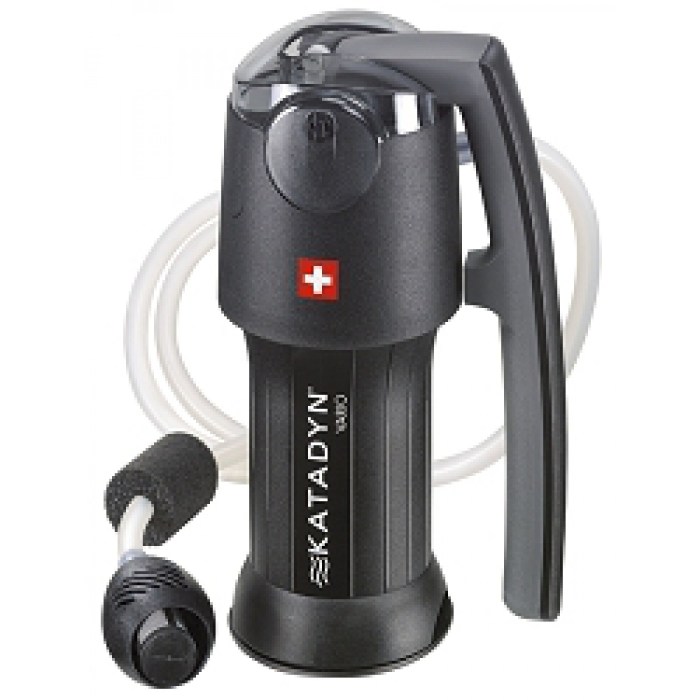
Choosing the right water purification system for your camping needs depends on several factors, including the type of water source, the number of people in your group, and the length of your trip. Here’s a guide to help you make the best decision:
First, consider the type of water source you’ll be using. If you’ll be camping near a clean, flowing water source, such as a river or stream, a simple filtration system may be sufficient. However, if you’ll be camping near a stagnant water source, such as a pond or lake, you’ll need a more powerful purification system that can remove bacteria and other contaminants.
Next, consider the number of people in your group. If you’re camping with a large group, you’ll need a water purification system that can handle a higher volume of water. Finally, consider the length of your trip. If you’re going on a short trip, you may be able to get by with a smaller, more portable water purification system.
However, if you’re going on a longer trip, you’ll need a larger system that can produce more water.
Water Purification System Types
There are several different types of water purification systems available, each with its own advantages and disadvantages. Here’s a brief overview of the most common types:
- Filtration systemsremove particles from water by passing it through a filter. Filtration systems are relatively inexpensive and easy to use, but they can only remove particles, not bacteria or other contaminants.
- Disinfection systemskill bacteria and other contaminants by adding chemicals to the water. Disinfection systems are more effective than filtration systems at removing contaminants, but they can also leave a chemical taste in the water.
- Ultraviolet (UV) systemsuse ultraviolet light to kill bacteria and other contaminants. UV systems are very effective at removing contaminants, but they can be more expensive than other types of water purification systems.
- Reverse osmosis (RO) systemsremove contaminants by forcing water through a semi-permeable membrane. RO systems are very effective at removing contaminants, but they can be expensive and require a lot of energy to operate.
Conclusion
Choosing the right water purification system for camping is essential to ensure a safe and enjoyable outdoor experience. By considering the factors discussed in this article, you can select a system that meets your specific needs and provides you with clean, safe drinking water.
Remember, staying hydrated while camping is crucial, and having access to a reliable water purification system can give you peace of mind knowing that you have a safe water source. Whether you choose a filter, purifier, or a combination system, make sure to follow the manufacturer’s instructions for proper use and maintenance to ensure optimal performance and longevity.
Final Thoughts
Choosing the appropriate water purification system for camping involves evaluating factors such as water source, desired level of purification, flow rate, ease of use, and portability. Filtration systems, chemical disinfection, UV disinfection, and boiling are common methods employed in water purification.
Understanding the advantages and disadvantages of each system empowers campers to make informed decisions based on their specific requirements.
By carefully considering the factors discussed in this article, campers can ensure they have access to clean and safe drinking water during their outdoor adventures. Water purification systems are essential for protecting health and enhancing the overall camping experience.
Q&A
How often should I replace my water purification filter?
Filter replacement frequency depends on the specific filter and usage. Generally, filters should be replaced every few months or after a certain number of gallons of water have been filtered.
What is the best water purification system for backpacking?
Lightweight and portable water purification systems, such as filtration bottles or UV pens, are ideal for backpacking due to their ease of use and convenience.
Can I use tap water in my water purification system?
Most water purification systems are designed to treat water from natural sources, such as rivers or lakes. Using tap water may not be necessary unless the tap water is known to be contaminated.

